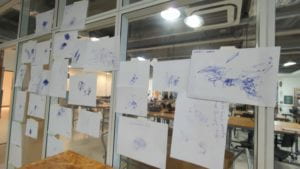Recitation 4: Drawing Machines
Recitation 4: Drawing Machines
We are going to do our mid-term group project in the following weeks. In Today’s recitation, we made a drawing machine which is a typical example of an interactive artifact.
Step1: Build the Circuit
I used the code from stepper_oneRevolution to make my motor rotates smoothly. This step can help me ensure whether I have made the right circuit and code before adding the potentiometer.
Fortunately, I completed it smoothly and the motor rotates as the following video shows.
Video:
Step 2: Control rotation with a potentiometer
To make the drawing machine interactive, we add a potentiometer as the input. By rotating the potentiometer, the rotating angle of the motor changes accordingly.
In the beginning, I had some trouble with the code letting Arduino read the signal from the potentiometer. Then, I fixed the problem with the help of the fellows and my partner.
Step 3: Build a Drawing Machine!
My partner and I build the drawing machine together and it works well!
But, it’s hard to control the potentiometer in order to let the drawing machine draw a specific shape.
Video & Photo:


Code:
/* * MotorKnob * * A stepper motor follows the turns of a potentiometer * (or other sensor) on analog input 0. * * http://www.arduino.cc/en/Reference/Stepper * This example code is in the public domain. */ #include <Stepper.h> // change this to the number of steps on your motor #define STEPS 200 // create an instance of the stepper class, specifying // the number of steps of the motor and the pins it's // attached to Stepper stepper(STEPS, 8, 9, 10, 11); // the previous reading from the analog input int previous = 0; void setup() { // set the speed of the motor to 30 RPMs (9600); stepper.setSpeed(30); } void loop() { // get the sensor value int val= analogRead(0); val=map(val,0,1023,0,200); // move a number of steps equal to the change in the // sensor reading stepper.step(val - previous); // remember the previous value of the sensor previous = val; }
Questions
Question 1: What kind of machines would you be interested in building? Add a reflection about the use of actuators, the digital manipulation of art, and the creative process to your blog post.
I would like to build machines with wonderful visual effects. For example, a machine that can generate changeable combinations of a variety of lights and colors activated by the frequency of users’ voices is a good one for me. It can also be a mirror reflecting lights and changes according to the move of viewers. As the visual effect is the first thing viewers get, a wonderful appearance at the first sight will attracts people a lot. Also, it can convey the intentions and implications of the artists better because their are more explicit.
In order to realize this kind of ideas, we ought to add components. Actuators help components to move. For example, we use the motor to make the pen move. From my perspective, it’s kind of a process of stimulating human behaviors. With actuators together with other equipment, the machine are able to do much more things.
When it comes to digital manipulation of art, it can demonstrate our thoughts in mind accurately and explicitly. It helps us to make the stretch and improve our plan easily. Also, it’s necessary for the product design industry when creating machines since it fits with the industrial standards so that others can understand with ease.
As for the creative process, I believe the most important part is coming up with a great idea which is feasible and creative. To achieve that, we should brainstorm a lot, listening to others’ ideas and being careful about our daily lives. And then, we start to make our prototypes. When prototyping, we can make sketches, models and drawings to record our thoughts and test their feasibility from the beginning. Finally, we make the product, test them, reflect and improve. Actually, the creative process involves digital manipulation of art and actuators.
Question 2: Choose an art installation mentioned in the reading ART + Science NOW, Stephen Wilson (Kinetics chapter). Post your thoughts about it and make a comparison with the work you did during this recitation. How do you think that the artist selected those specific actuators for his project?
I would like to choose Daniel Rozin, Mechanical Mirrors: Wooden Mirror,1999-2008. It is a computer-controlled mirror recreating digitized video images of viewers by electromagnetically manipulating a pixel-like array of wooden blocks painted with different grey-scale values. Both drawing machines and mechanical mirrors use motors to make visual effects, but they have different input components. One is potentiometer and the other is the camera. I think that the artist chose his actuators based on his intended purpose which he wanted to convey. So the form is based on the function.
 @
@